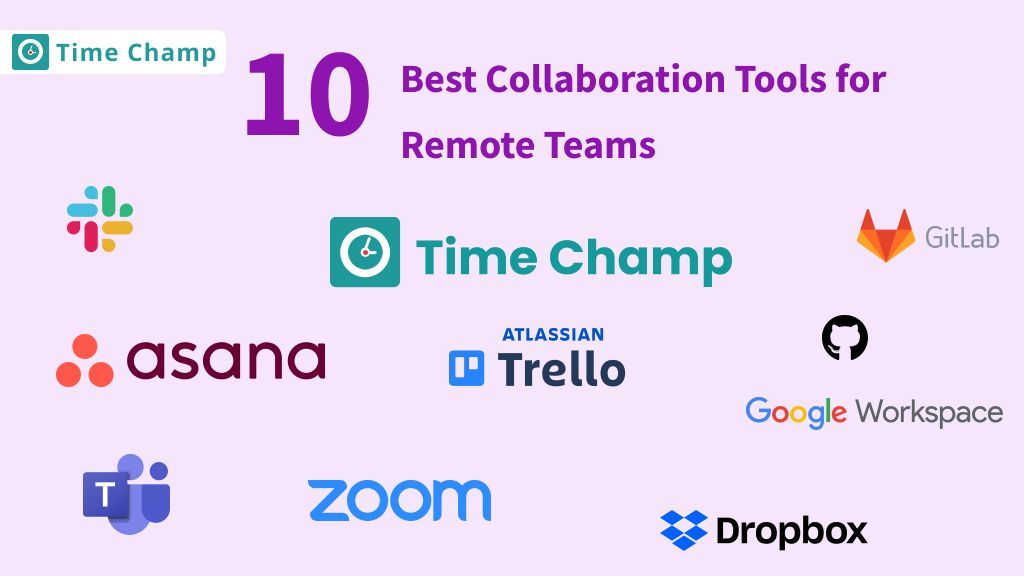As remote work grows, managing your remote team can be challenging—how do you keep everyone in sync, complete tasks on time, and manage projects smoothly? You are probably searching for tools that make your teamwork simple without adding extra complications. With collaboration tools, you can solve these issues easily. In this blog, we will look at the top 10 best collaboration tools for remote teams to stay connected, boost efficiency, and manage tasks easily!
What are Remote Collaboration Tools?
Remote collaboration tools assist your teams to work efficiently when they are working from different locations. These tools provide text chat, video conference, file transfer, and project collaboration features. You can share information with your remote team members and you can manage your projects easily.
These tools help to manage your remote work by addressing communication and collaboration issues effectively. In the present day, there is a need to have better communication and productivity between your teams, and this is where remote collaboration tool comes in handy.
10 Best Collaboration Tools for Your Remote Teams
Choosing the right tools is essential for your remote teams to stay connected and productive. Here’s a list of the top tools that can help you to improve communication, manage tasks, and collaborate effectively.
1. Trello
Trello is a project collaboration tool for managing tasks where tasks are organized in boards, lists, and cards. It is easy to use which is ideal for small teams or individual workers who do not need a complicated tool to monitor their progress. Every task is a card that can be in the “To Do,” “In Progress,” or “Done” state; you can assign tasks to team members, set deadlines, add comments, and attach files to a card.
Trello has a feature of dragging and dropping, which makes it easy to monitor the progress. Trello also works with other applications such as Slack and Google Drive so that you can create a workflow that is suitable for your team.
Trello Key Features:
Use boards, cards, and lists to organize your tasks and projects visually.
Easily share boards with team members, assign tasks, and comment on cards.
Add due dates, labels, checklists, and attachments to customize task management.
Connect Trello with other tools like Slack, Google Drive, and more for seamless workflow integration.
Trello Pricing:
Free: $0
Standard: $5 per user/month (billed annually)
Premium: $10 per user/month (billed annually)
Enterprise: $17.50 per user/month (billed annually)
Reviews:
G2: 4.4 out of 5
Capterra: 4.5
2. Asana
Asana is a project management tool that offers a platform for handling tasks and projects. It helps in the coordination and timing of activities. It enables you to create to-do lists, assign tasks to individuals, set deadlines, and track the progress of projects. Another thing that Asana does well is the timeline which helps to manage complex processes.
It is especially useful for teams that need to have a vision of their projects and tasks to work effectively. Asana also has an automation feature to minimize the time spent on repetitive tasks. Asana’s customizable processes and reporting tools ensure that everyone stays informed so that you can meet your project goals on time.
Asana Key Features:
Organize tasks, set deadlines, and track progress for projects.
Share tasks, assign team members, and communicate directly within tasks.
Visualize projects using list, board, calendar, or timeline views.
Connect with tools like Slack, and Google Drive, and automate workflows with rules and custom templates.
Asana Pricing:
Personal: $0
Starter: $10.99 per user/month (billed annually)
Advanced: $24.99 per user/month (billed annually)
Reviews:
G2: 4.4 out of 5
Capterra: 4.5
3. Time Champ
Time Champ is the best time-tracking and project management software designed for effective collaboration. With features like Kanban boards and drag-and-drop features, it enhances your team’s performance by enabling you to allocate tasks and monitor working hours seamlessly. Time Champ also helps you to organize your project workflows, track the progress of your projects, and set deadlines to ensure that everyone is on track.
It assists you in defining your company objectives, creating sprints, tasks, or work items, and managing your budgets. You can generate project reports, work log reports, and timesheets on how your team is utilizing their time and where they can improve.
Time Champ Key Features:
Create tasks and assign them to team members
Organize tasks, set deadlines, and track progress for projects.
Add due dates, labels, checklists, and attachments to customize task management
- Track time spent on each task
Automatic attendance
Employee monitoring & activity tracking
Productivity tracking
Timesheets & invoices
- Location tracking
Time Champ Pricing:
Time Champ offers a 7-day free trial, allowing you to explore its all features for unlimited users.
Time Champ offers three types of pricing plans: annually, quarterly, and 3-years.
Time Champ offers annual pricing with the Starter Plan at $2.39 per user/month, the Professional Plan at $3.58 per user/month, and the Enterprise Plan at $6.57 per user/month.
For more pricing details, including quarterly and 3-year plans, refer to the official Time Champ pricing page.
Reviews:
G2: 4.8 out of 5
Capterra: 4.9
4. Google Workspace
Google Workspace has features such as Google Drive, Docs, Sheets, and Slides, which enable your team to work on documents, spreadsheets, and presentations simultaneously. One can share files with the team members, collaborate on documents, and leave comments for others.
Everything is in the cloud, so there is no need to worry about where your documents are stored. Google Workspace is ideal for teams that require simultaneous document editing since it is integrated effortlessly.
Google Workspace Key Features:
Access to Gmail, Google Drive, Google Docs, Sheets, Slides, and more for seamless document creation and collaboration.
Generous cloud storage for files and emails, with secure access from any device.
Integrated tools for real-time collaboration, video conferencing (Google Meet), and team chat (Google Chat).
Centralized management for users, security settings, and data compliance features for businesses of all sizes.
Google Workspace Pricing:
Business Starter: $1.64 per user/month
Business Standard: $8.79 per user/month
Business Plus: $16.49 per user/month
Enterprise: Contact the Google Workspace sales team for enterprise pricing
Reviews:
G2: 4.6 out of 5
Capterra: 4.7
5) Dropbox
Dropbox is an online file-hosting service that provides a platform for storing and sharing files. It allows you to transfer and share large files with your co-workers or clients in a very efficient way. You can also share files and work on them simultaneously and access them from any device.
Some of the tools that are integrated with Dropbox include Microsoft Office and Slack making it more useful. It has strong security features that ensure the protection of your data making it a suitable tool for businesses that need to store their data securely.
Dropbox Key Features:
You get secure, scalable cloud storage for your files which you can access from any device.
It allows you to share files and folders with other people and work with them simultaneously, making comments and changes.
Your files are backed up automatically and synchronized across all your devices
You also get to enjoy features such as file encryption, two-factor authentication, and controls for managing team members.
Dropbox Pricing:
Plus: $9.99 per month
Essentials: $16.58 per month
Business: $15 per user/month
Business Plus: $24 per user/month
Reviews:
G2: 4.4 out of 5
Capterra: 4.5
6. Slack
Slack is one of the most widely used communication tools for remote teams. It enables your team to communicate in real-time and to create channels for different projects or teams so that the conversation does not get messy. You can use direct messages for short conversations. For a project, to share ideas, or even to share progress, slack is a convenient way to communicate with your teams.
It also allows you to integrate with other tools such as Google Drive, Zoom, and Trello, making work easier across different platforms. Slack also has its own bots that can help you schedule and complete tasks and keep everyone on schedule. It is used commonly by businesses of all sizes due to its ease of use and the ability to work in real-time.
Slack key Features:
Real-time messaging and audio/video meetings with Huddles.
Channels to organize team discussions and Clips for sharing updates.
Tools like Canvas and Lists for managing projects and documents.
Integrations with other apps, automated workflows, and robust security features.
Slack Pricing:
Pro: $7.25 per user/month (billed yearly) or $8.75 (billed monthly).
Business: $12.50 per user/month (billed yearly) or $15 (billed monthly).
Enterprise Grid: Custom pricing.
Reviews:
G2: 4.5 out of 5
Capterra: 4.7
7. Microsoft Teams
Microsoft Teams offers you messaging, video conferencing, and file-sharing features in one platform. It is compatible with other Microsoft Office applications such as Word, Excel, and PowerPoint through which you can also work on documents simultaneously.
Teams also have additional features for video conferencing which makes it ideal for virtual meetings. It can be used to set up and conduct meetings, share screens, and use the whiteboard for group discussions. It is a perfect tool for both communication and document sharing.
Microsoft Teams Key Features:
Video conferencing, online meetings, and screen sharing with options for custom backgrounds and webinars.
Instant messaging and file sharing for seamless collaboration.
VOIP and business phone features, including a contact center.
Integration with Teams Devices and apps for enhanced workflows and frontline workforce management.
Microsoft Teams Pricing:
Teams Essentials: $1.37 per user/month (annual subscription)
Microsoft 365 Business Basic: $1.73 per user/month (annual subscription)
Microsoft 365 Business Standard: $9.16 per user/month (annual subscription)
Reviews:
G2: 4.3 out of 5
Capterra: 4.5
8. Zoom
Zoom is the most popular application for video conferencing and online meetings. It enables you to make video calls, conduct meetings, webinars, and even virtual events. Zoom offers team features such as screen sharing, breakout rooms, and recording options to ensure that your team stays connected and can work remotely.
It is particularly helpful for remote teams that require frequent live meetings. Zoom is easy to use to connect with your teams. You can also record meetings and save chat logs in Zoom to review discussions or share them who couldn’t attend live.
Zoom Key Features:
Video conferencing, webinars, and online meetings with features like screen sharing and breakout rooms.
Recording options for meetings and saving chat logs.
Easy setup for connecting with teams and participants.
User-friendly interface and integration with various apps.
Zoom Pricing:
Basic: Free for up to 40-minute meetings with 100 participants and limited features.
Pro: $13.14 per user/month (billed annually) or $15.53 (billed monthly)
Business: $19.90 per user/month (billed annually) or $23.88 (billed monthly)
Reviews:
G2: 4.5 out of 5
Capterra: 4.6
9. GitHub
GitHub is the most used platform for sharing and collaboration of code. It allows the software development teams to store and manage the code, track the changes, and collaborate on the projects. GitHub’s version control system ensures that all the members of the team can work on the code at the same time without compromising the other’s work.
It is also useful in code review and bug tracking and therefore is a very important tool for development teams. GitHub is popular among developers, and most of the open-source projects are located on this site.
GitHub Key Features:
It allows you to track changes that you have made to your code over time.
It allows you to collaborate with other people by sharing code, reviewing changes, and tracking issues.
You can store and manage your code in well-organized project folders.
GitHub Actions can be used to integrate with other tools and also perform various tasks.
GitHub Pricing:
Free: $0 per user/month
Team: $4 per user/month
Enterprise: $21 per user/month
Reviews:
G2: 4.7 out of 5
Capterra: 4.8
10. GitLab
GitLab is another popular tool for software development teams that provides version control, continuous integration, and project management features. It allows you to share code, report issues, and generally organize the development process.
GitLab also has integrated project management tools which will help your team to monitor the progress and deadlines. Due to the availability of all the tools in one platform, GitLab is suitable for teams requiring a single software development platform.
GitLab Key Features:
It allows you to monitor changes that you make to your code over some time.
You and your team can work on code together using merge requests, code reviews, and issues.
It also has integrated CI/CD tools that allow you to test and deploy code changes automatically.
You will coordinate your work with the help of project boards, milestones, and tasks to track the progress.
GitLab Pricing:
Free: $0 per user/month
Premium: $29 per user/month (billed annually)
Reviews:
G2: 4.5 out of 5
Capterra: 4.6
Why Collaboration Tools Are Essential for Remote Teams?
Collaboration tools for remote teams are key to overcoming the challenges of remote work. Here’s how they are essential for your teams:
Facilitates Communication Across Time Zones
When your employees are working from different time zones, communication between your teams is quite challenging. You can easily communicate with your remote teams by using communication tools for virtual teams such as Slack or Microsoft Teams for instant messaging and setting up meetings. Then every team in your organization can communicate effectively at any time they connect.
Streamlines Project Management
It is challenging to manage projects remotely without the right tools. Using Time Champ, Trello, or Asana, helps you manage your projects, and you can easily assign tasks, set deadlines, and track your team’s performance in real-time. These tools provide you with a summary of the project and its progress, which can assist you in monitoring all the projects efficiently. These tools are handy when you are working with several teams or on several projects, as they help to avoid confusion and delays.
Ensures Transparency and Accountability
You can enhance transparency and accountability by letting you know who is working on what. The team members are aware of what tasks or projects their colleagues are working on; thus, it reduces confusion and delays. Having features such as task assignments, real-time updates, and activity logs helps you make sure that everyone is on track with their responsibilities.
Enhances Productivity and Efficiency
According to a Forrester Research study, using collaborative tools helps to improve your team’s productivity significantly. These tools make your teams more efficient and focused. And using project management tools lets you see tasks and deadlines, helping you prioritize work, and minimize time spent on emails and unnecessary meetings. As a result, you can dedicate more time to important tasks, ultimately increasing your team’s productivity.
Encourages Team Bonding and Interaction
One of the major challenges of working remotely is that employees are unable to meet their colleagues and managers face-to-face. However, there are platforms like Zoom or Slack that help you to organize virtual team-building activities. You can set up daily or weekly video conferences, virtual coffee meetings, or even organize online team-building events.
These interactions enhance trust and cooperation within the team. Buffer’s State of Remote Work 2023 report, shows that 43% of remote workers miss the social interactions at the workplace.
Conclusion
To wrap it up, use the right collaboration tools to make your remote work much easier. These tools allow you to communicate effectively with your remote teams, manage projects efficiently, and enhance your organization’s overall productivity.
Collaboration tools provide real-time messaging, video conferencing, task tracking, and seamless file-sharing to overcome the challenges you are facing with your remote teams. Choose the right tools that fit your team’s needs to stay organized and improve your productivity!
Frequently Asked Questions
To work with remote teams, it is necessary to define communication protocols, objectives, and communication tools to be used. Scheduling daily stand-ups and other virtual meetings ensures that everyone is on the same page. Promote openness and responsibility to facilitate efficient working relations within the team.
Yes, collaboration tools enhance the productivity of remote workers because they require less time to use than other forms of communication and project tracking. They offer quick and timely feedback, thus minimizing the use of emails and meetings. With the help of task assignments and deadlines, the teams will be able to work and organize their time properly.
Time zone differences are addressed in collaboration tools through the use of asynchronous communication such as calendars and task lists. They also have scheduling options that can be set to different time zones. This makes it easy for the teams to work together, especially for those that are located in different locations.







